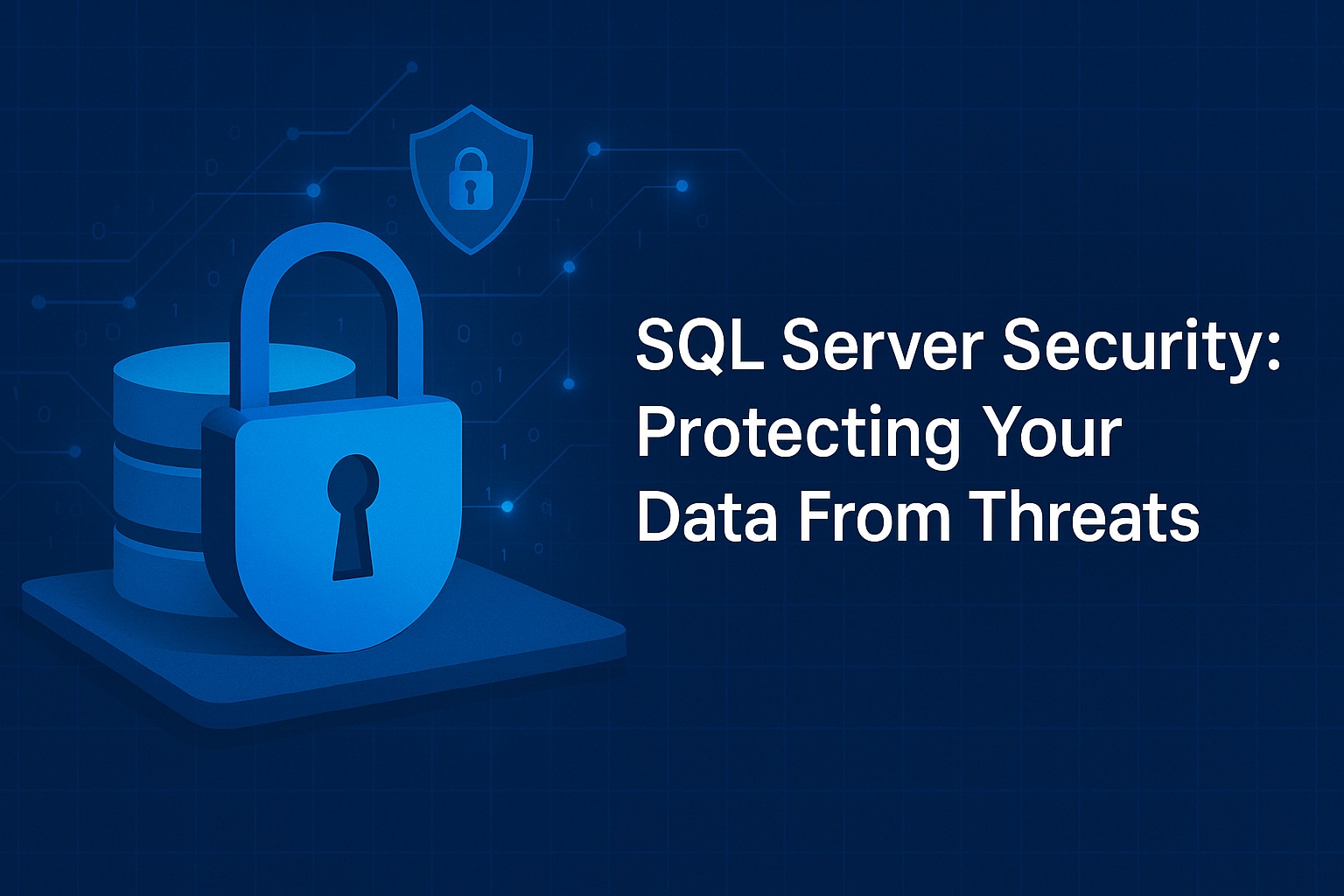If your organization isn’t focused on data security, it’s time to make some changes, particularly if you rely on SQL Server to manage and store valuable information. Cyber threats, data breaches, and malicious attacks are on the rise—and they are constantly evolving. That’s why it’s essential to have robust security measures in place.
SQL Server has several built-in security features, but you must take a proactive approach to protect your data. In this guide, we’ll go over what SQL Server is, SQL Server’s security features, common security threats you should be aware of, SQL Server security best practices, and some real-life examples of security breaches that highlight the importance of having top-notch SQL Server security.
What is SQL Server?
SQL Server is a relational database management system that was developed by Microsoft and initially released in the 1980s. SQL Server was created to help with storing, retrieving, and managing data using Structured Query Language (SQL). It uses tables to organize and structure data and can seamlessly integrate with other products in the Microsoft ecosystem, including Power BI and Azure.
Today, SQL Server is a powerful and widely used database solution. Not only is it capable of supporting small-scale business databases, but it can also handle large enterprise systems while still providing excellent performance, scalability, and data security. Thanks to features such as Always On Availability Groups and Failover Clustering, SQL Server offers a high level of availability and disaster recovery, allowing your business to maintain uptime and minimize data loss in the event of failures.
Notable editions of SQL Server include:
- SQL Server Enterprise: Designed for large organizations, the SQL Server Enterprise edition offers full scalability as well as incredibly fast performance and strong data security features. It also has end-to-end business intelligence, meaning it can provide valuable data insights.
- SQL Server Standard: This edition provides a more basic data management solution. Small organizations and departments with minimal IT resources can securely run their applications using SQL Server Standard.
- SQL Server Web: SQL Server Web provides essential database management features without the high cost of enterprise-level solutions. It is ideal for small to medium-sized web-based applications.
- SQL Server Developer: The SQL Server Developer edition has all the functionality of SQL Server Enterprise and allows developers to build applications on top of SQL Server. However, it can’t be used as a production server, so it’s best if you are looking to only build and test applications.
- SQL Server Express: This edition of SQL Server is free. It’s ideal for people looking to learn and build small applications.
Understanding SQL Server Security
SQL Server has several built-in security features to help organizations protect their data from unauthorized access, breaches, and other threats. One of the most critical SQL Server database security features is encryption. SQL Server offers multiple encryption methods to protect data both in transit and at rest. You can configure Transport Layer Security (TLS) (using a valid X.509 certificate) to encrypt all client-server communications and disable legacy protocols, such as SSL 3.0 and TLS 1.0. For data at rest, enable Transparent Data Encryption, which encrypts database files and backups using a database master key stored securely in Windows (via DPAPI).
SQL Server’s authentication and authorization capabilities add another layer of security. SQL Server supports Windows Authentication, which authenticates and authorizes users connecting through their Windows account with the Windows principal token. Windows Authentication uses Kerberos by default (falling back to NTLM only if Kerberos fails), offering integrated single-sign-on and mutual authentication with Active Directory, making it the most secure login method for on-premises SQL Server. Alternatively, SQL Server Authentication lets you create SQL-native logins. Because credentials must be stored (and often appear in connection strings), we recommend storing connection strings in a secure vault and using strong, regularly rotated passwords.
In addition to Dynamic Data Masking and Always Encrypted (introduced in SQL Server 2016), consider using role-based access control (RBAC) for field-level data protection. You can quickly assign specific roles and permissions to users, providing them access to the data and functions they need to complete their jobs without giving them free rein over the entire database. This minimizes data security risks by reducing the likelihood of unauthorized access or accidental modifications. Predefined server-level roles include sysadmin, serveradmin, securityadmin, processadmin, setupadmin, bulkadmin, diskadmin, and dbcreator. Database-level roles include db_owner, db_datareader, db_datawriter, db_ddladmin, db_securityadmin, and public. However, you can also create custom roles to meet your organization’s specific security goals and policies.
SQL Server security can be enhanced with Row-Level Security (RLS), which restricts access to specific rows in a table based on user roles. This feature provides fine-grained control over data visibility, making it particularly valuable for compliance-driven industries, multi-tenant applications, or scenarios requiring data segmentation.
By taking advantage of these built-in SQL Server security features, your organization can improve data protection, mitigate risks, and better ensure compliance with various industry and regulatory standards.
Common SQL Server Security Threats
There are a few common SQL Server security threats you need to know about, including:
- Privilege escalation: Privilege escalation, or when a user gains higher-level access or permissions than they are authorized for, is a significant security threat that can occur due to misconfigurations, vulnerabilities, or exploiting flaws in the system.
- SQL injection attacks: Bad actors can inject commands into query strings, which are then executed by the SQL Server. This can let attackers bypass the authentication process, access sensitive data, modify databases, delete records, and ultimately damage or corrupt your database.
- SQL Server authentication: While many organizations opt to use SQL Server authentication, it opens the door for connection string injection attacks. This can lead to attackers gaining unauthorized access or escalating privileges within your database, so it’s better to use Windows Authentication when possible.
- Denial-of-service (DoS) attacks: Application-layer DoS attacks are another problem you should be wary of. Attackers can overwhelm your database with fake queries or execute incredibly resource-intensive queries. This exhausts the system’s resources, prevents legitimate users from accessing or performing essential operations, and can result in significant system downtime.
- Verbose errors: Often, SQL Server database error messages contain valuable internal information about your database structure, server environment, stack traces, and more. If attackers gain access to these verbose error messages, they can potentially identify vulnerabilities in your system and plan more effective attacks.
- Social engineering attacks: Social engineering attacks are manipulative tactics attackers can use to trick people into sharing private information, including login credentials, or granting unauthorized access. Common examples of social engineering attacks include phishing emails, phone calls, baiting, and the fabrication of scenarios that convince the target to divulge sensitive information.
- Lack of security expertise: Finally, while not a direct threat in the same way as the previous attacks, a lack of data security expertise within your organization can create significant vulnerabilities and leave you more susceptible to attacks. Not only can this lead to improperly configured SQL Server databases, but it can also result in key security practices such as data encryption, patch management, and regular SQL Server database security audits slipping through the cracks.
Best Practices for SQL Server Security
To secure your SQL Server, you should follow a few SQL Server security best practices. Make sure to:
- Follow the principle of least privilege: Give users only the minimal level of access they need to perform their tasks. This reduces the attack surface by limiting the potential damage if an account is compromised.
- Regularly review permissions: Make sure to review user roles and permissions regularly to ensure they align with current job responsibilities.
- Use RBAC: Using RBAC can help ensure users have appropriate access to your database. By defining roles and assigning users based on their job functions, you can manage permissions more efficiently and prevent users from accessing sensitive data they don’t need.
- Implement encryption: Encryption can help protect your data from unauthorized access while it is at rest and in transit.
- Use multi-factor authentication (MFA): Enabling MFA can add a layer of protection since it requires users to authenticate their identity with more than just a password. They may also need to enter a one-time passcode sent to their email or mobile device or provide biometric verification via facial recognition or a fingerprint, which reduces the risk of unauthorized access when passwords are compromised.
- Enable auditing and logging: With SQL Server’s auditing and logging features, you can more easily track and understand actions performed on your database, user activities, and SQL Server database security threats.
- Disable unnecessary services and protocols: Every additional service and protocol increases your attack surface area, so if you aren’t using certain ones, it’s best to disable them to reduce potential entry points for attackers.
- Use firewalls: Firewalls can help prevent malicious traffic from reaching SQL Server, so make sure to enable the built-in Windows Firewall and any of your own firewall solutions. Remember to monitor your firewall logs for suspicious activity.
- Regularly update your SQL Server and operating system: Make sure to stay on top of patches and security updates for both your SQL Server and its underlying operating system, as this can protect you from known vulnerabilities.
- Maintain a strong password policy: Create a strong password policy, and make sure every employee adheres to it. It’s best to choose passwords that are difficult to guess, have numbers, special characters, capital letters, and lowercase letters, and aren’t in use on multiple systems. Users will also need to change their passwords periodically.
- Have a backup and disaster recovery strategy: Even if you follow all these SQL Server security best practices, things can still go wrong. So, it’s important to have a solid SQL Server backup and disaster recovery strategy. This involves setting a regular schedule with differential backups, transaction log backups, and full backups, and storing these backups in a secure yet accessible location; verifying your backups; and encrypting them. You should also outline the steps you will take if a disaster occurs so you can get your SQL Server back up and running as quickly as possible.
SQL Server security case studies
In 2007, attackers used SQL injection to access payment systems for multiple companies, including Hannaford, Heartland, NASDAQ, Carrefour, JetBlue, Dow Jones, Commidea, and, most notably, 7-Eleven. The attackers were able to steal over 160 million credit card numbers and use them for fraudulent transactions.
Similarly, in 2011, members of Anonymous, a group of hackers and activists who conducted cyberattacks against governments, corporations, and other institutions, were able to exploit an SQL injection vulnerability. They breached HBGary, an IT security firm, after the head of HBGary Federal, Aaron Barr, said that he knew the names of the leaders of Anonymous. They were able to take down the HBGary website, take over Aaron Barr’s Twitter account, erase files, control the company’s email, and add copies of internal documents to the internet.
To reduce the risk of SQL Server attacks, you should use a security monitoring solution. SolarWinds® Security Event Manager (SEM) monitors your SQL Server by collecting logs in real time, alerting you to unusual activity, and helping you meet compliance needs. SEM shows you important SQL Server events and makes it easier to respond to incidents.
Complementing SEM, Database Performance Analyzer (DPA) and SQL Sentry® deliver comprehensive performance insights and optimization strategies, ensuring your SQL Server environment remains both secure and high-performing.
Learn more about how SEM, DPA, and SQL Sentry work together to improve your SQL Server security and performance.


